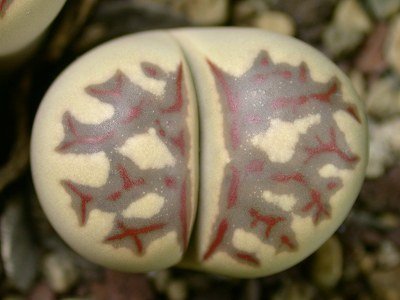
Lithops dorotheae (Rowlette)
Lithops have always been a very interesting plant for me. They stay pretty small in size, and produce flowers once a year that can be just as large as the plant. Germination tends to be rather easy considering the care for the adult plant. Care for Lithops can be confusing at first. The natural growing conditions explain perfectly why this is so. In nature, Lithops live in harsh conditions.
Germination for Lithops is very similar to cacti. The seeds have to have sunlight to sprout. This is a requirement that many cacti and succulents have. Burying the seeds results in no germination. I have found that the easiest way to sprout them is to have a small aluminum cake pan or anything you can use like a mini greenhouse. I've been using an aluminum pie tin with a clear lid. Just line the bottom with some succulent potting mix. Half an inch is plenty to get them started. Sprinkle the seeds on top of the soil. Try to separate them, but the seeds can be pretty challenging to deal with. If everything is set up correctly, you could have them sprouting in a few days. I would expect a longer germination time going into this though. It can vary depending on lighting and temperature.

Lithops in Dormancy (Rowlette)

Lithops Flowering (Rowlette)

Lithops in Growth (Rowlette)

Lithops in Growth (Rowlette)
The plants themselves resemble rocks in nature. These plants consist of two leaves unless the plant is in growth. When in growth, they grow two new leaves from the inside. These grow to be larger than the existing leaves. The plant then absorbs the old pair of leaves. The water is retained as much as possible. The plant typically goes from dormancy in summer, flowering in fall, and growth during the winter. Seeds are produced with flowering, and can be harvested for germination. As Rowlette states, the timing for the growth stages can vary depending on species. If someone is going to have an issue growing Lithops, it would be improper watering for the growth stage of the plant. Watering during the wrong time can easily rot these plants.
These plants originate in southern Africa. Many succulent enthusiast will recognize this location. There are hundreds of the most unusual plants native to Africa. These locations get very little water. As Nick Rowlette describes on his site lithops.info, "at least one species of Lithops depends on mist or fog to provide its main source of moisture" (Rowlette). The appearance of these plants is intended to camouflage the plants. They appear to be rocks from the top. Half buried, these plants can be pretty hard to spot.
Citations:
Rowlette, Nick. "Cultivation of Lithops: Lithops." Lithops, Nick Rowlette, www.lithops.info/en/index.html. Accessed 4 Sept. 2023.
This is my first time of seeing this kind of plant. It's amazing! God actually blessed every nation with different plant species.
Wishing you the best